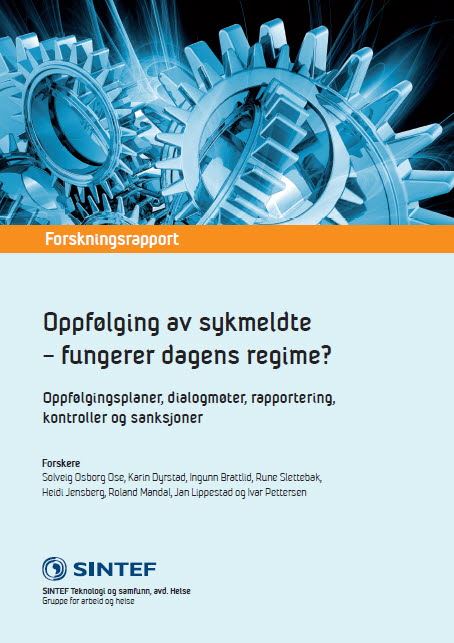In this report we examine the follow-up routines for sick-listed employees. Important elements in the current follow-up regime are follow-up plans, dialogue meetings, activity demands, controls, and sanctions.
Evaluating the effect of a system is different than evaluating its functionality. In order to measure the actual effects on the specific objectives of the system, researchers need to conduct controlled experiments or similar other methods that isolate the effect of interest and control for other intervening processes. Such trials should be initiated before the full-scale implementation of a measure. Since the authorities and the social partners chose not to initiate such trials before implementing the system, it is impossible to strictly test the effects of the various elements of the follow-up regime of sick-listed employees. What is possible after a system has been implemented is to evaluate how well the system works through a thorough collection and analysis of data. This is what we do in this project. Our overall research question is
Are the various aspects of the follow-up practice of sick-listed employees useful, and is it likely that they have the intended effect on the sick absence?
The main elements in the current follow-up routine examined in this report are the following duties and obligations:
- In collaboration with the employee, the employer should make an individual follow-up plan within the first four weeks of sick absence.
- The health professional who issued the sickness certificate (usually the employee's general practitioner (GP)) should receive a copy of the plan.
- If the employee has been on a (graded) sick leave for seven weeks, the employer should take the initiative to Dialogue meeting 1 (DM1).
- The health professional who issued the sickness certification should participate in DM1 unless the employee does not want him or her to be present, or it is deemed unnecessary.
- The occupational health service (OHS) should be present at DM1.
- The follow-up plan should be updated at DM1.
- Within 9 weeks of sick-leave, the employer should send the follow-up plan and a report form with information on the follow-up process to the Norwegian Labour and Welfare Service (NAV).
- The local NAV office should initiate Dialogue meeting 2 (DM2) within 26 weeks of absence. Participation is compulsory for both employer and employee, while the GP or other health professionals should participate if this is appropriate.
- If the employer, employee, or NAV finds it necessary, DM2 should be advanced.
- It is possible to ask for a Dialogue meeting 3.
- NAV should sanction parties who do not comply with their responsibility in the follow-up process, including the employer, employee and the general practitioner.
- The duties in the follow-up process are the same whether the sick leave is graded or full.
If the parties do not comply with their duties, the employer could face a fee equivalent of six court fees (NOK 5,160 as of 1 July 2011) for each violation of duties. The employee runs the risk of a halt in the sickness benefit, while the general practitioner runs the risk of a fee equivalent of 12 court fees (NOK 10,320 as of 1 July 2011) if he or she fails to meet at seven or more dialogue meetings. The issuer of sickness certificates could also lose the right to issue sickness certificates. NAV will only initiate sanctions after a prior warning.
Data and methods
To evaluate how well a system works, it is necessary to gain insight from all the parties in the system. The follow-up regime of sick-listed employees consists of the following actors:
- Employee/ sick-listed
- Employer
- The person who issued the medical certificate (usually the employee's general practitioner)
- The occupation health service
- NAV
These actors have different roles, duties and demands in the current follow-up regime. In order to answer the research question in this project, we have conducted more than hundred interviews with different actors for several years. We have also conducted large, national surveys among employees, employers, general practitioners, occupational health service staff, and NAV consultants. All the interviews have been digitally recorded, transcribed and coded. The material makes up several thousand pages of transcribed interviews. Through a unique coding technique, the interviews are fully coded in order to make full use of the data and conduct thorough analyses.
For projects like the present to have a value beyond the narrow project definition, which is perhaps the difference between research and consulting, it has to be founded on previous research and placed in a larger context. We have gathered the experience of each of the five actors listed above and given them a separate chapter. In each chapter, we provide a thorough summary and discussion of national and international state of the art literature. This has been the starting point for our own provision of research-based knowledge.
The research group responsible for this report, Group for labour and health research, is a multidisciplinary research group which consists of economists, political scientists, sociologists, educationists, and health professionals (one GP and one nurse). The methods employed span from qualitative interviews to complex analyses based on register data. As existing data gave few answers to the research questions, a large part of the project has been dedicated to data collection, and interviews have been conducted up to the very end of the project. The last extensive data collection took place in March 2013, where 10,000 enterprises were asked to share their experiences on the follow-up regime in a large-scale survey.
The project is authorised by the Regional Committee for Medical and Health Research Ethics (2011/2045/REK ) and the Norwegian Social Science Data Services (NSD no. 27830 and 27896).

